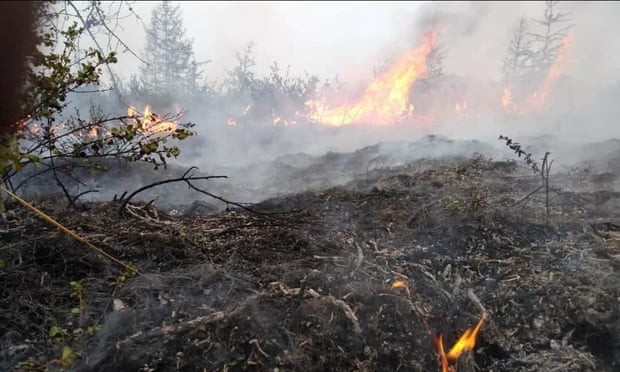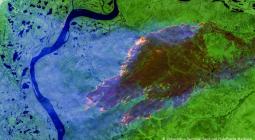Siberia heatwave was 'almost impossible' without climate change, scientists say.
An extreme heatwave in the Arctic is a problem for the entire planet, say scientists, because the region regulates weather around the globe and contains much of the world's carbon-rich permafrost.
A recent heatwave in Siberia that saw temperature records tumble as the region sweltered in 38-Celsius highs was "almost impossible" without the influence of man-made climate change, leading climate scientists say.
An international team of researchers found that the record-breaking warm period was more than 2 degrees hotter than it would have been if humans had not warmed the planet through decades of greenhouse gas emissions.
The five hottest years in history have occurred in the last five years and there's a better-than-even chance that 2020 will be the hottest ever recorded.
Earth's poles are warming faster than the rest of the planet, and temperatures in Siberia - home to much of the world's carbon-rich permafrost - were more than 5 degrees hotter than average between January and June.
One town, Verkhoyansk, recorded a temperature of 38C - smashing previous records.
Andrew Ciavarella, senior detection and attribution scientist at Britain's Met Office, described the findings as "staggering".
"This is further evidence of the extreme temperatures we can expect to see more frequently around the world in a warming climate," he said.
The impact of climate change on extreme weather events such as super storms and droughts is now well-established, but until fairly recently scientists have been unable to definitively link an individual event to global warming.
As part of a growing area of climate research known as attribution science, the team ran computer simulations of temperatures with the climate as it is today - around 1 degree hotter than the pre-Industrial era baseline.
They then compared this to a model generating temperatures over Siberia this year without human influence - that is, without the additional man-made 1 degree.
They found that the prolonged heat would happen less than once every 80,000 years without human induced climate change.
This makes the heatwave "almost impossible in a climate that had not been warmed by greenhouse gas emissions", the team said, adding that carbon pollution had made the extreme event at least 600 times more likely to occur.
'Important for everyone'
The team behind the calculations stressed that the Siberian heatwave was a problem for the entire globe. Some 1.15 million hectares of forest going up in flames released millions of tonnes of CO2 into the atmosphere.
At the same time, the wildfires and sustained heatwaves accelerated the region's permafrost melt. This caused an oil tank built on frozen soil to collapse in May, leading to one of the region's worst-ever oil spills.
"Such a prolonged heat wave is important, not only for its influence on people, but also from a scientific point of view," said Olga Zolina, from Russia's PP Shirshov Institute of Oceanography.
"The Arctic is very, very important generally for forming of weather and circulation. So such high temperatures are really important for the whole globe."
While the research was compiled rapidly and has not yet been subjected to peer-review, authors said it produced "among the strongest results of any attribution study conducted to date".
The 2015 Paris climate deal commits nations to capping temperature rises to "well-below" 2 degrees above pre-industrial levels and to strive for a 1.5 degrees limit if at all possible. With just 1 degree of warming so far, Earth is already buffeted by record-breaking droughts, wild fires and super storms made more potent by rising sea levels.
To keep in line with the 1.5-degree target, the United Nations says global emissions must fall by 7.6 per cent every year this decade.
Sonia Seneviratne, from ETH Zurich's Department of Environmental Systems Science, said the research showed the heatwave was an example of "extreme events which would have almost no chance of happening" without man-made emissions.
SBS NEWS
Climate change made Siberian heatwave 600 times more likely – study
Human fingerprint on record temperatures ‘has rarely, if ever, been clearer’, says report.

The record-breaking heatwave in the Siberian Arctic was made at least 600 times more likely by human-caused climate change, according to a study.
Between January and June, temperatures in the far north of Russia were more than 5C above average, causing permafrost to melt, buildings to collapse, and sparking an unusually early and intense start to the forest fires season. On 20 June, a monitoring station in Verkhoyansk registered a record high of 38C.
An attribution study shows such prolonged heat over the first six months of the year would have been almost impossible without the effect of greenhouse gas emissions from industry, transport and farming.
The team of researchers from international universities and meteorological services, including the PP Shirshov Institute of Oceanology in the Russian Academy of Science, calculated this human impact added at least 2C of warming to the region.
The authors of the study say the Siberian heat would happen less than once in every 80,000 years without human interference.
Andrew Ciavarella, a lead author of the research and senior detection and attribution scientist at the Met Office, said the findings were staggering. “This research is further evidence of the extreme temperatures we can expect to see more frequently around the world in a warming global climate. Importantly, an increasing frequency of these extreme heat events can be moderated by reducing greenhouse gas emissions.”
Scientists say the human fingerprint has rarely, if ever, been clearer. “This is the largest signal we have seen,” said Friederike Otto, the acting director of Oxford’s Environmental Change Institute and a co-lead of the World Weather Attribution initiative. “This study shows again just how much of a game-changer climate change is with respect to heatwaves. As emissions continue to rise, we need to think about building resilience to extreme heat all over the world, even in Arctic communities – which would have seemed nonsensical not very long ago.
The need for stronger resilience was evident when melting permafrost and poorly maintained equipment led to one of Russia’s worst oil spills, from a power station near the industrial city of Norilsk, on 29 May.
Prof Olga Zolina, of the Institute of Oceanology in Moscow and another lead author, said the fate of Norilsk could be an indicator of what lies in store for other northern communities. “It means we should do something. This town is very small, with about 1,000 inhabitants. But there are other bigger cities in the Arctic circle. For them the mounting high temperatures are very important.”
Concerns are also growing that the high temperatures are worsening positive feedback loops by melting heat-reflecting ice and increasing the range and intensity of wildfires in Siberia, which is home to the world’s largest forest.
The season’s fires started unusually early, in April, and have been detected further north than ever before. According to the EU’s Copernicus satellite monitoring service, Siberian blazes released 59 megatonnes of carbon dioxide in June, the highest amount on record.
Nasa says some embers smoulder through the winter in peatlands and then flare back to life in the spring. The dangers of such “zombie fires” is increased by warmer temperatures. The melting of the tundra also increases the risks of a release of methane, a highly potent greenhouse gas. Since the middle of June, the extent of the fires has more than doubled to more than a million hectares.
The Arctic is warming faster than anywhere on the planet, but the trend towards more extreme conditions is apparent elsewhere. At the start of the year, Australia had unprecedented bushfires and Antarctica registered exceptionally high temperatures.
Some scientists believe this calendar year could break the heat record set in 2016. Gavin Schmidt, the director of the Nasa Goddard Institute for Space Studies in New York, said this week there was now a three-in-four chance that 2020 would be the hottest year ever, up from his 60% estimate in April.
The UK Met Office is more cautious. Despite several record months, it said global average surface temperatures in 2020 were still not at 2016 levels and a cooling La Niña was now developing. “While 2020 is running very high, there is no guarantee of a record this year,” said Prof Adam Scaife, the head of Met Office long-range prediction.
15 July 2020
The Guardian




